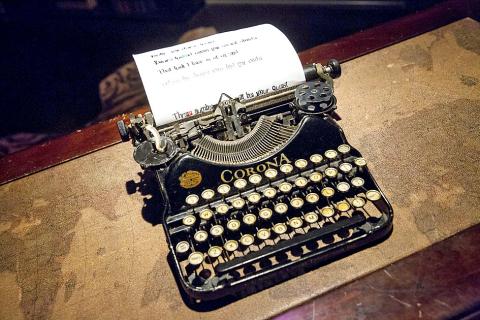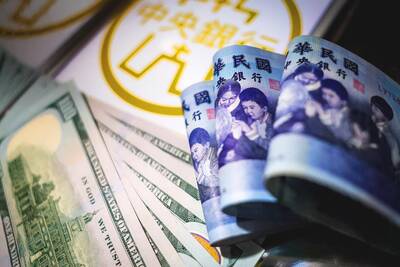Dental lab technician Jon Choi and his friends celebrated his birthday this month under pressure: They were locked together in a small “escape room” and had to solve a series of puzzles to achieve their freedom within 60 minutes.
They finally made it out with one minute to spare.
Choi avidly plays computer games with the same set-up, but had never visited a physical escape room before. The experience was both fun and tough enough that he is now planning to try other similar rooms.

Photo: Reuters
He has plenty of options. Escape rooms are the latest entertainment phenomena to seize the US, where people break out of locked rooms using their smarts, or any that the friends, family members or strangers interred with them may possess. There are more than 100 across the country, according to the Escape Room Directory, charging between US$20 and US$30 for the experience.
In an era when socializing no longer requires real-time conversation and the answers to all life’s questions are a screen-tap away, those seeking to connect with others in person and use their own knowledge for intellectual challenges find the rooms refreshing. The concept has captivated Americans so much that the Science Channel created the game show Race to Escape around it.
Themes of the independently owned rooms vary from place to place. In Pittsburgh, families are encouraged to share “bonding time” in the “Prison Escape” room. In Los Angeles, players can relive their city’s Raymond Chandler past in a room called “The Detective.”
Once the door is closed and the timer set, the first puzzle emerges. Its solution leads to the next puzzle. Clues are tucked all over the room, some in plain sight and others in secret compartments. Step by step, players solve the overarching mystery of the room.
For Choi and his friends at Escape Room Live in Alexandria, Virginia, that mystery revolved around fictional detective Sherlock Holmes.
“We looked up at the time and there was 10 minutes left and I was like: ‘God,’” said Andew Kim, who was shocked when they finally cracked the mystery.
According to Escape Game Orlando, the rooms’ roots are in video games, with the basic idea of trapping a player in a single location first appearing in the 1988 game Behind Closed Doors. A real-life room opened in Kyoto in 2007 and the trend soon spread throughout Asia and Europe, according to the company.
When Ginger Flesher-Sonnier started Escape Room Live a year ago in Washington with a secret agent-themed room, she was surprised by the demand.
Within three weeks, Flesher-Sonnier, a former math teacher, had to create a second room at the site and within nine months, she opened the Alexandria location featuring two Holmes-themed rooms. In August alone, 6,000 people visited both Escape Room Live locations.
So many people have tramped through that, after rent and salaries, prop storage has become the company’s biggest expense. It must have exact duplicates of all the puzzle objects ready to swap in every few weeks.
Flesher-Sonnier estimates that 60 percent of visitors are millennials. Corporate team-building provides many customers and three men have popped the question by having engagement rings hidden in puzzles.
Few players solve the mysteries in time without getting hints from the game masters who monitor and run the rooms. They have seen that the puzzles bring out all sorts of quirks in people’s personalities and relationships.
“I think strangers work the best. The reason why is you can’t get mad at a stranger,” the manager of the Alexandria location, Hop Dang, said. “Families — they don’t hold back.”
Dang attended his first escape room a year ago, thinking: “Why am I paying someone to lock me in a room?”
Now he often dreams at night about secret doors and hidden objects.
The world tends to look different to people once they have escaped, Dang said.
“Every thing that you see, you’re going to try to open,” Dang said.

SETBACK: Apple’s India iPhone push has been disrupted after Foxconn recalled hundreds of Chinese engineers, amid Beijing’s attempts to curb tech transfers Apple Inc assembly partner Hon Hai Precision Industry Co (鴻海精密), also known internationally as Foxconn Technology Group (富士康科技集團), has recalled about 300 Chinese engineers from a factory in India, the latest setback for the iPhone maker’s push to rapidly expand in the country. The extraction of Chinese workers from the factory of Yuzhan Technology (India) Private Ltd, a Hon Hai component unit, in southern Tamil Nadu state, is the second such move in a few months. The company has started flying in Taiwanese engineers to replace staff leaving, people familiar with the matter said, asking not to be named, as the

The prices of gasoline and diesel at domestic fuel stations are to rise NT$0.1 and NT$0.4 per liter this week respectively, after international crude oil prices rose last week, CPC Corp, Taiwan (台灣中油) and Formosa Petrochemical Corp (台塑石化) announced yesterday. Effective today, gasoline prices at CPC and Formosa stations are to rise to NT$27.3, NT$28.8 and NT$30.8 per liter for 92, 95 and 98-octane unleaded gasoline respectively, the companies said in separate statements. The price of premium diesel is to rise to NT$26.2 per liter at CPC stations and NT$26 at Formosa pumps, they said. The announcements came after international crude oil prices

DOLLAR SIGNS: The central bank rejected claims that the NT dollar had appreciated 10 percentage points more than the yen or the won against the greenback The New Taiwan dollar yesterday fell for a sixth day to its weakest level in three months, driven by equity-related outflows and reactions to an economics official’s exchange rate remarks. The NT dollar slid NT$0.197, or 0.65 percent, to close at NT$30.505 per US dollar, central bank data showed. The local currency has depreciated 1.97 percent so far this month, ranking as the weakest performer among Asian currencies. Dealers attributed the retreat to foreign investors wiring capital gains and dividends abroad after taking profit in local shares. They also pointed to reports that Washington might consider taking equity stakes in chipmakers, including Taiwan Semiconductor

A German company is putting used electric vehicle batteries to new use by stacking them into fridge-size units that homes and businesses can use to store their excess solar and wind energy. This week, the company Voltfang — which means “catching volts” — opened its first industrial site in Aachen, Germany, near the Belgian and Dutch borders. With about 100 staff, Voltfang says it is the biggest facility of its kind in Europe in the budding sector of refurbishing lithium-ion batteries. Its CEO David Oudsandji hopes it would help Europe’s biggest economy ween itself off fossil fuels and increasingly rely on climate-friendly renewables. While